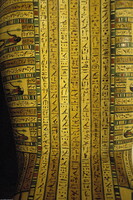Mummiform Coffin of Nespekashuty, Priest of Montu
unknown (Egyptian (ancient))

Download1A3-EG-LM-1-K3_cp.jpg (766.7Kb)
Date
-750--680Description
Detail of hieroglyphic text on lower leg and foot case of painted wooden coffin of the priest of Montu, Nespekashuty, Dynasty 25-26; The typical coffins of the 25th and 26th dynasties developed gradually from those of the preceding period. A transitional phase, ca. 750-680 BCE, led to a new range of styles, with relatively uniform decoration. Conscious archaizing was a feature, with a revival of designs popular in the 21st Dynasty, and even much earlier motifs, such as the two eyes on the side. Outer and inner mummiform coffins were covered with linen, plastered and painted in bright colours on a white or yellow ground. The decoration of the outer coffin lids consisted mainly of scenes such as the judgement of the soul and the mummy lying on a bier, alternating with columns of text in horizontal bands. A large inscription was usual on the case. Source: Grove Art Online; http://www.groveart.com/ (accessed 2/4/2008)
Type of Work
coffinSubject
death or burial, portraits, Egypt--Religion, Twenty-fifth Dynasty, Egyptian (ancient)
Rights
Rights Statement
Licensed for educational and research use by the MIT community only